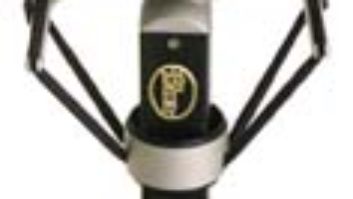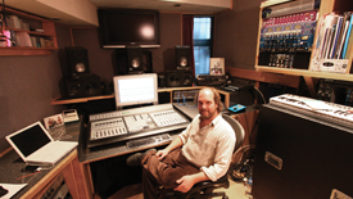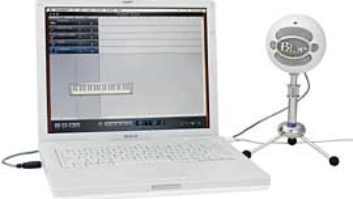CONDENSER MICROPHONEIn recent years, BLUE (Baltic Latvian Universal Electronics) has achieved recognition as a manufacturer of high-quality, handcrafted microphones.
BLUE’s latest offering, the Dragonfly, has a unique appearance and a very functional architecture, consisting of a round, pivoting enclosure housing the capsule. This enclosure rests on an integrated, shockmounted cradle (with mic stand adapter) attached to its stem.
The Dragonfly is a pressure-gradient, cardioid condenser design with a hand-crafted, 1-inch diaphragm capsule with a single layer of 6-micron Mylar film sputtered with a formulation of aluminum and pure gold. The electronics are Class A discrete, with transformerless output. The mic’s specs include a sensitivity level rated at 21mV/Pa (1 kHz into 1 kOhm), while its max SPL handling is a respectable 132 dB. The microphone has a 20 to 20k Hz frequency response, a signal to noise ratio of 87 dB (DIN/IEC 651, A-weighted) and self-noise of 7 dBA.
I checked out a pair of black-stemmed “standard issue” Dragonflies and two of BLUE’s 20-foot “Cranberry” high-definition cables. The optional Cranberry cable employs a two-conductor, twisted-pair design that rejects electro-magnetic interference. Gold-plated connectors round out the feature set.
BLUE also markets an upgraded green-stemmed, matched pair of Dragonfly mics on special order; these incorporate higher-grade electronics, a slightly denser capsule backplate on the capsule and a wood box. Unfortunately, the upgraded version of the mic can only be purchased as a pair ($2,800). I’m confident many recording professionals would gladly pay the difference for a single upgraded “Dragonfly LE,” if such a unit could be obtained.
Oddly, the “standard issue” Dragonfly does not use a gold-plated XLR connector, though the upgraded version does. While this may not significantly impact signal quality, I can’t help but wonder why BLUE opted not to provide a connector on par with those of the recommended cable.
IN SESSIONSetting up the Dragonfly requires removing two brass set screws from the solid metal ring surrounding the grille. The screws secure the capsule during shipment to help prevent damage, and you are encouraged to replace them whenever the mic is stored.
The Dragonfly has a cardioid response and should be positioned so the grille’s shiny side faces the desired sound source.
The Dragonfly’s horizontally pivoting capsule, combined with the integrated shockmount support, allows the mic to be placed in an almost infinite number of positions and is, without a doubt, one of its best features. Inside the circular grille, a finely woven inner screen protects the capsule from foreign elements and saliva.
I connected the Dragonfly through a Millennia HV-3B preamp and began working on a dialog session. The Dragonfly is quite sensitive to the letter “P” and other plosive sounds. For close proximity dialog work, a sheer nylon pop filter is essential.
The ability to angle the capsule works wonders for this application. After a bit of experimentation, the mic delivered outstanding takes with plenty of depth and definition, while relatively free of any undesired sibilance.
For vocal work, I followed the recommendation of the Dragonfly’s user guide. With the talent positioned roughly five inches directly in front of the mic, a slight upward angle of the capsule captured greater dynamic contrast during those “belting” portions of the hook. The Dragonfly has a fairly broad on-axis range, enabling one to position sound sources at various degrees off-center. This can help compensate for an understated midrange response; but more on that in a moment. With both dialog and vocal work, the Dragonfly was terrific at reproducing the articulation, and playback was every bit as easy to understand as the original performance.
The Dragonfly is not entirely transparent – there is a definite coloration to its sound. The mic delivers a very full, rich bottom end with a high end that borders on the bright side. There’s a low-end bump around 90 Hz and another bump about 14 kHz. The midrange, while not bland, is not as emphasized as the high- and low-frequency ranges.
I had a pair of Dragonflies and was eager to try them as drum overheads. The mics’ emphasized low- and high-frequency ranges make these exceptional for this application, yielding a detailed drum sound with plenty of low-end kick and high-end cymbal character. Further, the stereo imaging was another pleasant surprise. As the drummer played across multiple tom-toms, I could gain a sense of movement through the stereo field.
Given its ability to handle relatively high SPLs, I also tried the Dragonfly on a snare drum and a bongo drum. The sharp attack transients of these instruments can push a mic to the brink of distortion, but the Dragonflies offered ample headroom and their sound was dead-on accurate.
I also recorded electric and acoustic guitars, but with mixed results. With the electric guitar, the mic was exceptional. Placed approximately 15 inches directly in front of the speaker cabinet, but at a slight angle, the Dragonfly delivered all the nuances and aggressiveness of the guitarist’s rock performance. Further, the entire recording had a wonderful sheen to it.
However, for acoustic guitar, the Dragonfly would not be my first choice. Due to the accentuated low and high end, the acoustic guitar was unnaturally big at the low end. While the mic’s brightness didn’t bother me with higher-pitched notes, the guitar’s overtones lacked the subtlety of the original performance.
THOROUGHLY MODERN MICDespite the Dragonfly’s unorthodox appearance, this is a thoroughly modern microphone capable of delivering stellar results – but be prepared to experiment with positioning. While useful results may not come as easily as with other designs, the ability to position the capsule at so many angles relative to a sound source opens up a world of sonic opportunity.
All things considered – and even without a gold-plated XLR output – the BLUE Dragonfly is an exceptional mic exhibiting outstanding workmanship and capable of producing superb results. Though not particularly transparent, Dragonfly is great for pop/rock/R&B vocals, dialog work and recording percussion or other instruments with high SPLs. Priced at $1,199, Dragonfly is well within the financial reach of project and commercial studios seeking a truly professional, versatile microphone.







